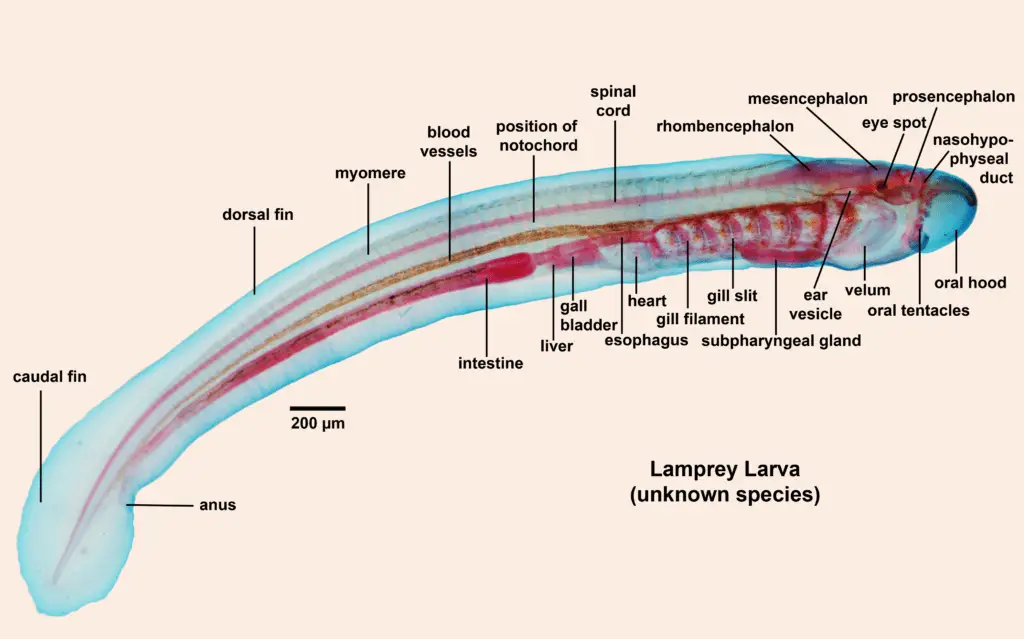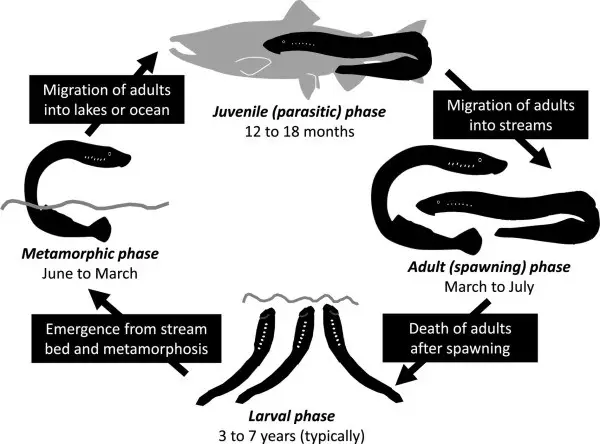Development in Petromyzon is indirect, their life cycle involves a certain larval stage after metamorphosis the larva convert into adult Petromyzon. Petromyzon is dioecious, male and female release gametes, in water fertilization occur externally. The female Petromyzon releases a large number of telolecithal eggs, but the eggs have a large quantity of yolk.
Then the zygote is divided into more cells through holoblastic unequal cleavage, the gastrula form as the gastrula show a specific type of invagination. Blastopore present on the posterio-dorsal side of the body, the blastopore in embryo become anus in adult Petromyzon.
Then different organs formation occur, some specific tissue form special organ, the formation of central nervous system start from solid keel-shaped tissue. Then the solid keel-like neural tissue form lumen inside it and finally form a hollow tubular central nervous system, this approach of development of the central nervous system is known as thickened keel method.
Larval Stage: The Ammocoet Larva:
The embryo inside the eggs takes nutrition from the yolk and finally becomes a miniature larva known as Ammocoet larva. When the Ammocoet larva reaches a specific stage, the eggs hatch and the Ammocoet larva comes outside of the eggs. It takes around 3 weeks after fertilization to become an Ammocoet larva, the Ammocoet larva show very strong dissimilarity with the adult Petromyzon.

The Ammocoet larva has a transparent body and when they come outside of the eggs they are around 7 mm. Then they remain in the nest few days until they reach a length of about 14 mm, then they come outside of the nest and build their own ‘V’ or ‘U’ shaped burrows in the sand or mud. They remain in those burrows, this larval stage runs for a very long time, in some species Ammocoet larval stage last for 3-4 year while in some species the larval stage may last for up to 7 years.
Importance of Ammocoet Larva:
The dissimilarity of Ammocoet larva with the adult Petromyzon and its similarity with the Cephaochordata indicates that Ammocoet larva is the intermediate between Cephaochordata and Vertebrata. The Ammocoet larva is a filter feeder, they have only a single continuous dorsal fin.
The respiration and digestion are more or less similar with Branchiostoma, the Ammocoet larva is not parasitic. So the Ammocoet larva does not have the sucking type buccal funnel as present in adult Petromyzon. But in Ammocoet larva, the mouth has an upper lip-like ridge which has a close resemblance with the oral hood of Branchiostoma.
In Branchiostoma the respiratory cum food current is produced by the ciliary movement but in Ammocoet larva, the water current is generated through the muscular contraction of the respiratory pharynx. The branchial basket supports the pharynx wall, the muscular contraction of the pharynx wall creates the flow of water through the mouth, the water in the mouth enters into the respiratory pharynx, the velum present at the way of respiratory pharynx control the entry of water in the pharynx.
The gill slits are 7 pairs, the gill sacs are connected to the respiratory pharynx through the internal gill slits and the gill pouches open outside through the external gill slits. During the night the Ammocoet larva come outside their burrow and feed on the microscopic organisms present on the oceanic floor, the unicellular algae, and other microscopic organisms trapped in the mucous secretion of the pharynx.
The heat is surrounded by the sac of the pericardium, the lateral eyes remain under the skin, the median eye is well developed but the nasal sac is not well developed.

Metamorphosis of Ammocoet Larva:
- The Ammocoet larva remain in this larval stage, the time span of the Ammocoet larva vary species to species, 4-7 years, after that they become semiparasitic adult.
- The upper and lower lip like oral hood become into fully functional suctorial buccal funnel, the teeth appear, the rasping tongue develop.
- The endostyle present in the pharynx of Ammocoet larva convert into thyroid gland.
- The velum develop more for protection of respiratory pharynx against entering food into the respiratory pharynx.
- The mouth lead to two separate tubular canal, one is the digestive tract and another one is the blind sac respiratory canal.
- The protonephridia present in Ammocoet larva now replaced by the mesonephric kidneys in adult Petromyzon.
- The nasal sac form infolding, the covered eyes in Ammocoet larva become now function on lateral side of the head.
- The dorsal single median fin was continuous in Ammocoet larva, it divides into anterior first dorsal fin and posterior second dorsal fin.
- The pericardium is connected to the coelom in Ammocoet larva, in adult stage the pericardial sac separated from the coelom.
- The spinal cord become flat ribbon like structure in adult Petromyzon, the body becomes transparent yellowish brown to opaque greenish brown.

Detailed Study On
Nervous System and Excretory System of Petromyzon
Respiratory System and Circulatory System of Petromyzon
Digestive System and Feeding Mechanism of Petromyzon
Anatomy of Petromyzon (Lamprey)
External Morphology of Petromyzon
Habit and Habitat of Petromyzon(Lamprey)
Classification of Class Ostracodermi
Phylogeny of Subphylum Vertebrata
An Overview of Classification in Subphylum Vertebrata
Subphylum Vertebrata and its Diversity
Cephalochordata Characteristics Features Classification Examples and Diagram
Urochordata Classification Morphology Characteristic Features
Characteristics Features of Hemichordata
General Comparison of Hemichordata Urochordata and Cephalochordata
Comparative Study of Digestive System in Hemichordata Cephaochordata and Urochordata
Hi Everyone!!! Welcome to Imaluop. Imaluop always try to learn some new and he want to share to other people. Here we will try to learn various topics on Science, specially on Biological Sciences.